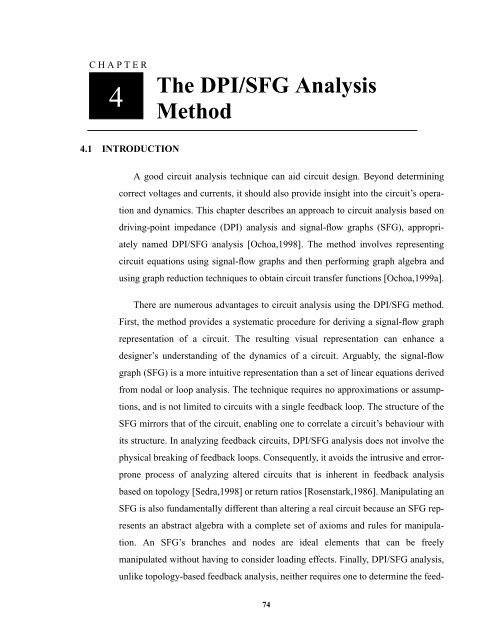CMOS Optical Preamplifier Design Using Graphical Circuit Analysis
CMOS Optical Preamplifier Design Using Graphical Circuit Analysis
CMOS Optical Preamplifier Design Using Graphical Circuit Analysis
You also want an ePaper? Increase the reach of your titles
YUMPU automatically turns print PDFs into web optimized ePapers that Google loves.
CHAPTER<br />
4<br />
4.1 INTRODUCTION<br />
The DPI/SFG <strong>Analysis</strong><br />
Method<br />
A good circuit analysis technique can aid circuit design. Beyond determining<br />
correct voltages and currents, it should also provide insight into the circuit’s opera-<br />
tion and dynamics. This chapter describes an approach to circuit analysis based on<br />
driving-point impedance (DPI) analysis and signal-flow graphs (SFG), appropri-<br />
ately named DPI/SFG analysis [Ochoa,1998]. The method involves representing<br />
circuit equations using signal-flow graphs and then performing graph algebra and<br />
using graph reduction techniques to obtain circuit transfer functions [Ochoa,1999a].<br />
There are numerous advantages to circuit analysis using the DPI/SFG method.<br />
First, the method provides a systematic procedure for deriving a signal-flow graph<br />
representation of a circuit. The resulting visual representation can enhance a<br />
designer’s understanding of the dynamics of a circuit. Arguably, the signal-flow<br />
graph (SFG) is a more intuitive representation than a set of linear equations derived<br />
from nodal or loop analysis. The technique requires no approximations or assump-<br />
tions, and is not limited to circuits with a single feedback loop. The structure of the<br />
SFG mirrors that of the circuit, enabling one to correlate a circuit’s behaviour with<br />
its structure. In analyzing feedback circuits, DPI/SFG analysis does not involve the<br />
physical breaking of feedback loops. Consequently, it avoids the intrusive and error-<br />
prone process of analyzing altered circuits that is inherent in feedback analysis<br />
based on topology [Sedra,1998] or return ratios [Rosenstark,1986]. Manipulating an<br />
SFG is also fundamentally different than altering a real circuit because an SFG rep-<br />
resents an abstract algebra with a complete set of axioms and rules for manipula-<br />
tion. An SFG’s branches and nodes are ideal elements that can be freely<br />
manipulated without having to consider loading effects. Finally, DPI/SFG analysis,<br />
unlike topology-based feedback analysis, neither requires one to determine the feed-<br />
74














